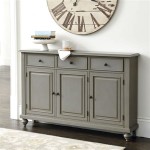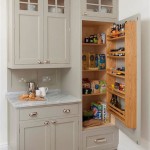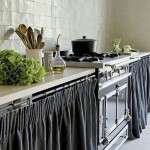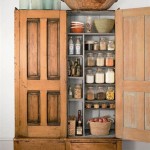What Wall Color Goes With Dark Kitchen Cabinets?
Selecting the appropriate wall color to complement dark kitchen cabinets is crucial in creating a visually appealing and balanced kitchen space. Dark cabinets, such as those finished in deep shades of brown, gray, navy, or black, introduce a sense of sophistication and depth to a kitchen. However, their inherent darkness can also make a room feel smaller or closed-in if the surrounding colors are not chosen thoughtfully. The ideal wall color will not only harmonize with the cabinets but also enhance the overall ambiance of the kitchen, maximizing light and creating a welcoming atmosphere. Several factors contribute to the optimal wall color selection, including the specific shade of the dark cabinets, the amount of natural light available in the room, the kitchen's style, and the homeowner's personal preferences. Understanding these elements allows for a more informed decision-making process, resulting in a kitchen that is both stylish and functional.
The perceived darkness of the cabinets is central to this decision. A nearly black cabinet will interact with light and color differently than a dark-stained cherry cabinet. The undertones present in the dark cabinets also play a significant role. Do the cabinets lean towards warm hues, such as auburn or chocolate, or do they have cooler undertones, like charcoal or navy? The wall color should either complement or intentionally contrast with these undertones to achieve the desired effect. Lighting is another key factor. A kitchen with ample natural light can handle bolder or darker wall colors, while a kitchen with limited natural light may benefit from lighter, more reflective shades. Furthermore, the style of the kitchen – whether it is modern, traditional, farmhouse, or eclectic – will influence the choice of wall color. A modern kitchen might benefit from a minimalist color palette, while a farmhouse kitchen could incorporate warmer, more rustic tones.
Consideration should also be given to the other elements within the kitchen, such as the countertops, backsplash, flooring, and hardware. These elements should work together to create a cohesive and harmonious design. For instance, if the countertops are light-colored, a wall color that complements the countertops can help to tie the space together. Similarly, the backsplash can serve as a source of inspiration for the wall color, either by matching a color within the backsplash or by choosing a complementary shade. Ultimately, the choice of wall color is a personal one, and it should reflect the homeowner's individual style and preferences. However, by considering the factors outlined above, it is possible to make an informed decision that will result in a kitchen that is both beautiful and functional.
Understanding the Undertones of Dark Cabinets
Identifying the undertones of the dark cabinets is paramount for selecting a complementary wall color. Undertones are subtle hues that lie beneath the surface color, influencing how the color is perceived. Dark cabinets can exhibit a range of undertones, including warm tones such as red, orange, and yellow, or cool tones such as blue, green, and gray. Accurately assessing these undertones is critical to selecting a wall color that harmonizes with the cabinets and prevents clashing. For example, dark cherry cabinets often have warm red undertones. Pairing them with a wall color that also has warm undertones, such as a creamy beige or a soft yellow, can create a cohesive and inviting space. Conversely, if the cabinets have cool gray or blue undertones, a wall color with similar cool undertones, such as a light gray or a muted blue-green, can create a sophisticated and calming atmosphere.
To accurately identify the undertones, it is beneficial to examine the cabinets in different lighting conditions. Natural light can reveal subtle undertones that might not be visible under artificial light. Comparing the cabinet color to a white surface can also help to highlight the undertones. Once the undertones are identified, it is possible to choose a wall color that either complements or intentionally contrasts with them. Complementary colors are those that are opposite each other on the color wheel, such as red and green, or blue and orange. Using complementary colors can create a vibrant and dynamic contrast, but it is important to use them sparingly to avoid overwhelming the space. Alternatively, analogous colors, which are those that are adjacent to each other on the color wheel, such as blue and blue-green, can create a more harmonious and subtle effect.
Furthermore, the intensity of the undertones should be considered. If the undertones are subtle, a wider range of wall colors may be suitable. However, if the undertones are strong, it is important to choose a wall color that is either a close match or a deliberate contrast. For instance, if the cabinets have a strong red undertone, a wall color that is too similar in intensity could create a visually overwhelming effect. In this case, a more muted or neutral wall color might be a better choice. Ultimately, understanding the undertones of the dark cabinets is essential for creating a cohesive and balanced kitchen design. By accurately identifying the undertones and choosing a wall color that complements or contrasts with them in a thoughtful manner, it is possible to create a kitchen that is both stylish and inviting.
Leveraging Light: Maximizing Brightness in the Kitchen
The amount of natural and artificial light in the kitchen significantly influences the selection of wall color. Dark cabinets absorb light, potentially making the kitchen feel darker and smaller. Therefore, it is essential to choose a wall color that reflects light and maximizes brightness, particularly in kitchens with limited natural light. Lighter wall colors, such as whites, creams, and light grays, are generally more reflective and can significantly brighten a dark kitchen. These colors bounce light around the room, creating a more spacious and airy feel.
In kitchens with ample natural light, there is more flexibility in the choice of wall color. While lighter colors are still a viable option, it is also possible to consider bolder or darker shades without making the kitchen feel too dark. For instance, a deep teal or a muted sage green can add a touch of color and personality to the kitchen while still complementing the dark cabinets. However, it is important to use these colors sparingly and to ensure that there is sufficient artificial lighting to compensate for the light absorption. Artificial lighting should be carefully planned to supplement natural light and to highlight key areas of the kitchen, such as the countertops and the cooking area. Recessed lighting, pendant lights, and under-cabinet lighting can all be used to create a well-lit and inviting space.
The sheen of the wall paint also affects light reflection. Higher sheen paints, such as semi-gloss or gloss, are more reflective than matte paints. However, high-sheen paints can also highlight imperfections in the walls, so it is important to ensure that the walls are properly prepared before painting. Eggshell or satin finishes offer a good balance between reflectivity and durability, making them a popular choice for kitchens. Furthermore, the placement of windows and the orientation of the kitchen can influence the amount of natural light that it receives. Kitchens that face north or east tend to receive less direct sunlight than those that face south or west. In these cases, it is particularly important to choose a light and reflective wall color to maximize brightness. By carefully considering the amount of natural and artificial light in the kitchen and choosing a wall color and sheen that enhance light reflection, it is possible to create a kitchen that is both bright and inviting, even with dark cabinets.
Popular Wall Color Choices and Their Impact
Several wall colors are frequently chosen to complement dark kitchen cabinets, each offering a unique aesthetic and impact on the overall kitchen design. White, in its various shades, remains a classic and versatile choice. A bright white provides a clean and crisp contrast to dark cabinets, making the space feel more open and modern. Off-whites, such as cream or ivory, offer a warmer and softer alternative, creating a more inviting and traditional atmosphere. Gray, ranging from light to mid-tone shades, is another popular option. Light grays provide a neutral backdrop that allows the dark cabinets to stand out, while darker grays can create a more dramatic and sophisticated look. The specific shade of gray chosen should be carefully considered in relation to the undertones of the cabinets and the amount of natural light in the kitchen.
Beige, with its warm undertones, is a comforting and timeless choice that complements dark cabinets well. Beige can create a cozy and welcoming atmosphere, particularly when paired with dark brown or cherry cabinets. However, it is important to choose a beige that is not too yellow, as this can create a dated or unappealing look. Blues and greens, in muted or pastel shades, can also be effective choices. Soft blues can create a calming and serene atmosphere, while muted greens can bring a touch of nature into the kitchen. These colors work particularly well with dark gray or navy cabinets. It is important to avoid overly bright or saturated blues and greens, as these can be overwhelming and clash with the dark cabinets. These colors are best used as accents, rather than dominate the scene.
For those seeking a more dramatic and bold statement, darker wall colors can be considered, but with caution. Deep teals, charcoal grays, or even black can create a sophisticated and luxurious look, but they should only be used in kitchens with ample natural light and high ceilings to prevent the space from feeling too small or enclosed. When using darker wall colors, it is important to incorporate plenty of light-colored accents, such as white countertops, light-colored backsplashes, and bright hardware, to balance the darkness and create visual interest. Ultimately, the choice of wall color is a personal one, and it should reflect the homeowner's individual style and preferences. However, by considering the factors outlined previously, it is possible to make an informed decision that will result in a kitchen that is both beautiful and functional.

16 Amazing Color Scheme Ideas For Kitchens With Dark Cabinets

The Best Color To Paint Your Kitchen If You Have Dark Cabinets

11 Ideas For Dark Kitchen Cabinets Paintzen

11 Ideas For Dark Kitchen Cabinets Paintzen

Choosing The Best Paint Colors For A Kitchen With Dark Cabinets Five Star Painting

Best Paint Colors For Kitchens With Dark Cabinets Jenna Kate At Home

16 Amazing Color Scheme Ideas For Kitchens With Dark Cabinets

16 Amazing Color Scheme Ideas For Kitchens With Dark Cabinets

14 Dark Kitchen Cabinet Design Ideas Sure To Impress Simply Kitchens

Wall Paint Color For Kitchen With Dark Cabinets Advice Needed
Related Posts








